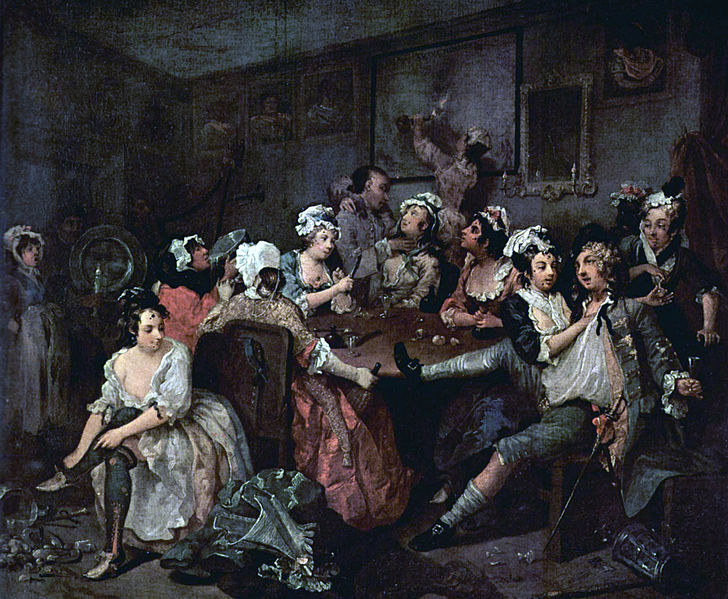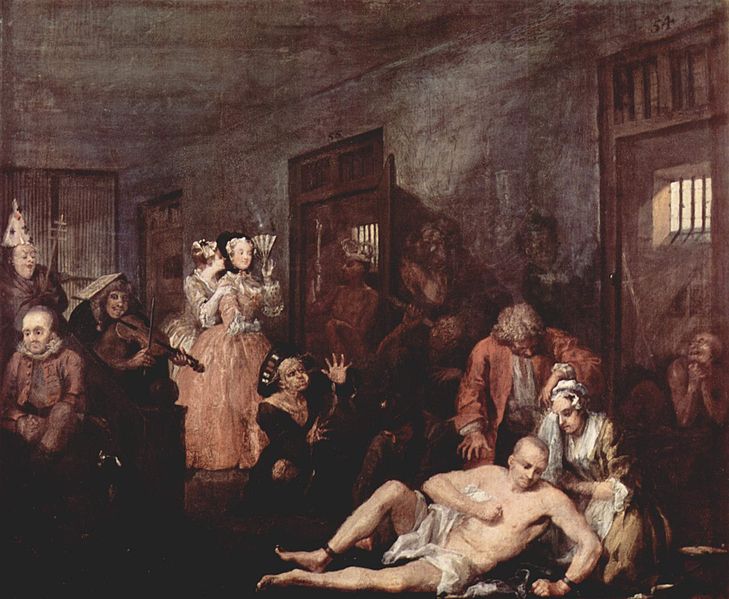My post yesterday on Little Nemo In Slumberland got me thinking about early comics and hence, the very first ones. While the first official “comic”, that is, sequential graphic storyline as we know it is The Adventures of Obadiah Oldbuck” in the mid 19th century (we’ll get to that tomorrow) there is a notable precursor.
The Rake’s Progress from 1733 is the first official example of sequential graphic storytelling made into print, although it was originally a series of paintings designed to go together. However, what makes it precursor to the modern comic is that the paintings were made into engravings and then published in print form.
The Rake’s Progress, by William Hogarth is of course a take on the famous Pilgrim’s Progress, a 1687 classic of english literature. A Pilgrim’s Progress is a religious morality tale, with very heavy handed metaphors in which the lead character Christian, journey’s from The City of Destruction to the Celestial City. He meets Evangelical (who helps him) Obstinate and Pliable (who try to turn him back), Mr. Wordly Wiseman and Mr. Legality (Boo!) the kind Good Will (Yay!) and the stalwart companion Faithful. You get it, right?
But fear not Dear Reader, i assure you Christian navigates all the obstacles and does indeed make it to the Celestial City. Alas, 45 years later, the same good fortune does NOT occur for Tom Rakewell in The Rake’s Progress.

“In the first painting, Tom has come into his fortune on the death of his miserly father. While the servants mourn, he is being measured for new clothes. He is also rejecting the hand of his pregnant fiancée, Sarah Young, whom he had promised to marry (she is holding his ring and her mother is holding his love letters). He will pay her off, but it is clear that she still loves him.”

“In the second painting, Tom is at his morning levee in London, attended by musicians and other hangers-on all dressed in expensive costumes. Surrounding Tom from left to right: a music master at a harpsichord; a fencing master; a quarterstaff instructor; a dancing master with a violin; a landscape architect; an ex-soldier offering to be a bodyguard; a bugler of a fox hunt club. At lower right is a jockey with a silver trophy. The instructor looks disapprovingly on both the fencing and dancing masters. Both masters appear to be in the “French” style, which was a subject Hogarth loathed.”

“The third painting depicts a wild party or orgy underway at a brothel. The whores are stealing the drunken Tom’s watch. On the floor is a night watchman’s staff and lantern. The scene takes place at the Rose Tavern a famous brothel in Covent Garden. The prostitutes have black spots on their faces to cover syphilitic sores.”

“In the fourth, he narrowly escapes arrest for debt by Welsh bailiffs (as signified by the leeks, a Welsh emblem, in their hats) as he travels in a sedan chair to a party at St James Palace to celebrate Queen Caroline’s birthday on Saint David’s Day (Saint David is the patron saint of Wales). On this occasion he is saved by the intervention of Sarah Young, the girl he had earlier rejected; she is apparently a dealer in millinery. In comic relief a man filling a street lantern spills the oil on Tom’s head. This is a sly reference to how blessings on a person were accompanied by oil poured on the head. In this case the “blessing” being the “saving” of Tom by Sarah, although Rakewell, being a rake, will not take the moral lesson to heart. In the engraved version, lighting flashes in the sky and a young pickpocket has just emptied Tom’s pocket. The painting, however, shows the young thief stealing Tom’s cane and has no lightning.”

“In the fifth, Tom attempts to salvage his fortune by marrying a rich but aged and ugly old maid at St Marylebone. In the background Sarah arrives holding their child while her indignant mother struggles with a guest.”

“The sixth painting shows Tom pleading for the assistance of the Almighty in a gambling den at Soho’s White Club after losing his “new fortune.” Neither he nor the other obsessive gamblers seem to have noticed a fire breaking out behind them.”

“All is lost by the seventh painting, and Tom is incarcerated in the notorious Fleet Debtor’s Prison. He ignores the distress of both his angry new (old) wife and faithful Sarah, who cannot help him this time. Both the beer-boy and the jailer demand money from him. Tom begins to go mad, as indicated by both a telescope for celestial observation poking out of the barred window and an alchemy experiment in the background. Besides Tom is a rejected play; another inmate is writing a pamphlet on how to solve the National debt. Above the bed at right is an apparatus for wings, which is more clearly seen in the engraved versiont.”

“Finally insane and violent, in the eighth painting he ends his days in Bethlehem Hospital (Bedlam), London’s celebrated mental asylum. Only Sarah Young is there to comfort him, but Rakewell continues to ignore her. While some of the details in these pictures may appear disturbing to modern eyes, they were commonplace in Hogarth’s day. For example, the fashionably dressed women in this last painting have come to the asylum as a social occasion, to be entertained by the bizarre antics of the inmates.”
And there you go. 8 panels, engraved and mass printed, the first storyboard, the first comic strip, (not all that comic, mind you, but whatever.) in any case the first example of printed sequential art. It was a runaway smash, the Batman of its day. William Hogarth also made the 6 plate series A Harlot’s Progress (Harlot came first, but the original paintings have been lost to time, although the black and white engravings remain.) Not to ruin the surprise ending, but The Harlot dies of syphilis.
AND, to brilliantly tie this post together, The Rake’s Progress also became a renowned Opera by the great Ivor Stravinsky notable also for the libretto being in English. As long as we’re here, let’s sign out with a snippet.
[youtube=http://www.youtube.com/watch?v=U7fyz9ZLDno]
Let's connect! Here is where you can find me: